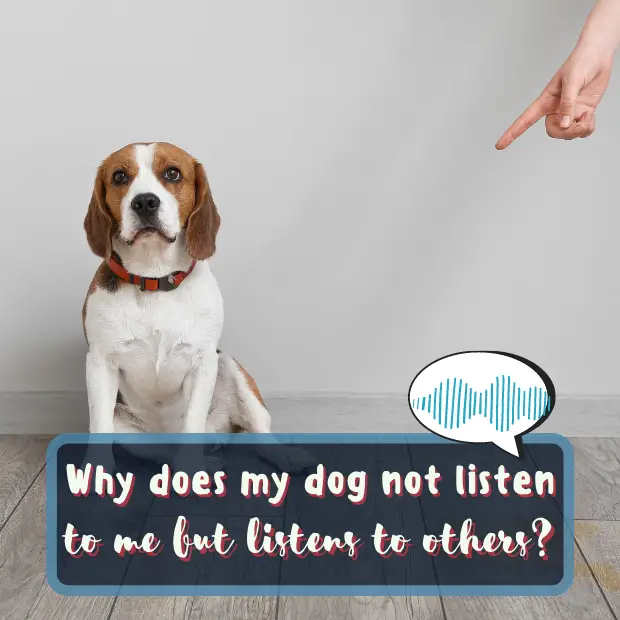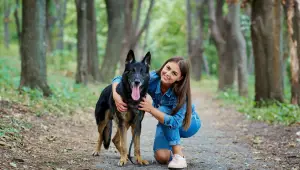Nothing is more frustrating than trying to get your dog to listen to you and having them completely ignore you. So why does this happen? Why does my dog not listen to me? There are a few factors that could contribute which comes down to how we interact with our dogs.
In this blog post, we’ll look at some of the reasons why your dog isn’t listening and explore ways to better train our furry friends.
Table of Contents
ToggleContents of this article:
Why Does My Dog Not Listen to Me?
The question of why our dog does not listen to us but does listen to others is a perplexing one. Let’s explore some possible explanations – and solutions!
1. Breed traits and genetics
Some dogs may be more independent and not as reliant on their owners for guidance.
Dog breeds that were originally bred to work fairly independently, such as huskies, hounds, and terriers, are more likely to exhibit this behavior.
Whereas gundogs and herding dogs are more likely to be attentive to their owners for direction.
2. Be calm and consistent
Dogs generally respond better to people who are calm and consistent in their commands. If we are constantly yelling at our dog or giving them conflicting instructions, they will likely get confused and tune us out.
On the other hand, if someone else is able to give clear and consistent commands, the dog is more likely to respond.
3. Positive interactions
It could also be that the way we interact with our dogs is not as effective as we think it is. Dogs are highly social creatures and love to play.
If we are constantly trying to get them to do things they don’t enjoy, they may start to resent it. However, if we make learning fun and include plenty of playtime, our dogs are more likely to be engaged and willing to please us.
One of my dogs used to just wander off during training sessions when he was a puppy. He’s a spitz type with a fairly independent streak and if he didn’t receive a reward for every attempt during a training session, he would lose interest, disengage and physically leave the room!
He taught me an awful lot about training methods!
4. Spend time with your dog
Dogs may be more responsive to other people because they have established a stronger bond with them. This could be due to the fact that the other person spends more time with the dog, or because they have a better understanding of how to communicate with them.
Dogs are highly social creatures and form strong bonds with the people they spend the most time with. So, if someone else in the household spends more time with the dog than the owner does, it’s likely that the dog will be more responsive to them.
5. Make it clear
It’s important for owners to be consistent with commands and rewards in order for dogs to understand them.
Dogs are much more likely to respond to commands if they know that they will be consistently rewarded for doing so. This could be in the form of treats, praise, or playtime.
If we are constantly changing what we expect from our dogs, they will quickly get confused and tune us out.
I have seen many dogs disengage from their owners because they know their owner has food but they do not understand what they need to do in order to achieve a reward.
6. Build trust
Owners should spend time training their dogs and building a relationship of trust. This can be done through obedience training, but it’s also important to spend time playing and bonding with your dog.
They need to know that you are a loving friend. Dogs that feel comfortable and trust their owners are much more likely to be responsive to them.
7. Positive reinforcement
Dogs learn best through positive reinforcement – rewarding them when they do what you ask of them. This could be in the form of treats, praise, or playtime.
If we are constantly scolding our dogs or yelling at them, they will quickly learn to tune us out and may even start to resent us.
However, if we make learning fun and include plenty of playtime, our dogs are much more likely to be engaged and enjoy their training time.
8. Be aware of your body language
Finally, it is also possible that our dogs simply do not understand us. Dogs communicate through non- verbal means, whilst we communicate through spoken language.
It’s possible that there is something very nuanced in the cue the dog obeys that we are not aware of, and the dog may be working from the person’s mannerisms rather than their verbal cues.
This is why it’s important to use clear commands and consistently reward our dogs when they obey us. With time and patience, our dogs will eventually learn what we expect of them.
What do you do when your dog won’t listen?
Dogs are amazing creatures that can provide us with companionship, love, and security.
They rely heavily on humans for direction and guidance, which is why it’s important to remember that being calm, consistent, and fun are the most important aspects of training a dog and teaching them it’s worth their while to listen to us.
If you’ve struggled getting your furry friend to listen to you, we hope this article has given you some insight into how dogs pay attention and what you can do to modify your behavior to better communicate with your canine companion.
Check out this post for information on how to teach a stubborn dog recall.







